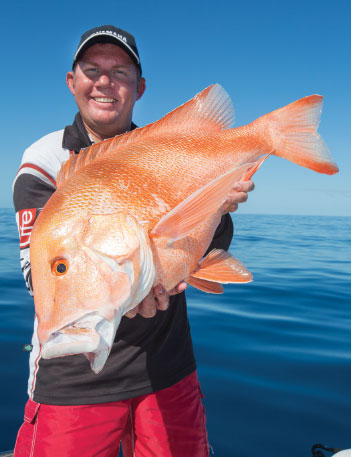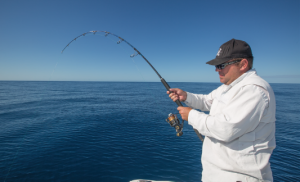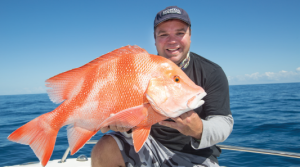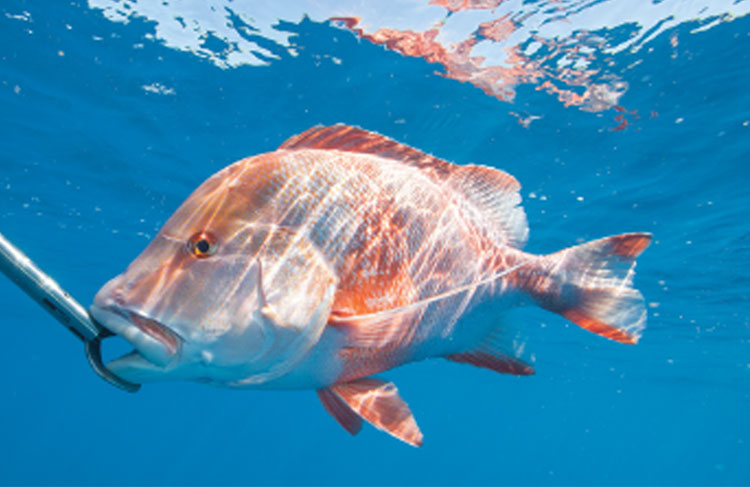Jason Wilhelm has been on a steep and exhilarating learning curve in his obsession with red emperor.
With some very impressive captures behind him, he shares valuable tips from the lessons he’s learned so far.
Some fish simply grab your attention. You know the type – visually striking, reaching impressive proportions, challenging as mongrels to catch, and utterly fantastic to eat… One species that ticks all these boxes and more is the mighty red emperor, a true celebrity of the fish world.
Just about everyone wants to catch red emperor, yet relatively few manage to get a good, consistent handle on them, maybe because details on how and where to get them seem to be shrouded in secrecy. Open discussion of hints and tactics for red success is about as rare as unicorn manure, and even rarer is the availability of GPS marks or starting points. You just know they’re really special fish when so few anglers are willing to share their knowledge.
This feature is by no means a definitive text on how to successfully target red emperor, basically because I have really only been chasing them for a few years. What I can offer, though, is some hard won insight, and I can share experiences that might launch budding red emperor anglers, or maybe recalibrate the processes of those who’ve tried to catch them before. One thing for certain is that everything here is based on fact, experience and results. Anyone who knows me will tell you that I’m no fan of guesswork, theories or myths. I reckon those three horrible words are responsible for stunting anglers’ growth more than any other factors.
The Beginning
My first forays into red fish was when I caught some saddletail snapper, or what Queenslanders commonly refer to as largemouth nannygai, or red jew. During the winter months, they showed up in fairly impressive numbers as bycatch on some of my local inshore haunts, mostly in the 3-5kg range. I wasn’t exactly smitten with them, but one day it all changed when I landed an 8kg fish and an 11kg fish in consecutive drops on one of the lesser known wrecks in my region. The reason it all changed was that these two bigger fish fell for large flesh baits, and not the usual soft plastic rig I favoured for most of my offshore fishing. Had I been missing out on something by casting plastics? It certainly looked that way. Happy as I was with the two cracking nannygai, what really got me was that on the same day I backed them up with an 8kg red emperor. I’ve fished for a lot of different species over my 30 years of angling, but none had stopped me in my tracks like that. I became intrigued, and all of a sudden, barramundi fishing seemed a lot less interesting. On top of it all, my new obsession was providing my family with a great feed of fish. The red fever was upon me! wrecks in reliable numbers. Nor did the nannygai – they were just passers by who’d drop in for a bit.
I was going to have to spend a lot of time on the sounder out in the open ocean paddock if I was going to find what I was looking for
– a reliable and untouched resource of red emperor, well away from the usual stomping grounds of anglers along the Central Queensland coast. It’s well known that red emperor and nannygai like a bottom feature known as ‘red fern’. This red and stringy soft coral is a favoured haunt, as are other soft corals and sponges that are generally found in the 40-60m depth contours east of the mid-Queensland coastline. This type of bottom feature is not everywhere, but when you find it, you’ll generally find reds. Using an underwater video camera supplied by Bay Auto Marine Electrical in Hervey Bay, I’ve been able to determine exactly what I’m looking at on my sounder. Through the use of the camera, which plugs directly into my Simrad NSS 12 evo2 or Lowrance HDS 9, I’ve been able to work out why the attraction of red fern is so strong for these fish. The answer is hardly surprising – the fern is a perfect haven for baitfish to shelter from predators – but the sheer numbers of baitfish and crustaceans that hold in these areas is astounding. So it makes perfect sense why this type of bottom feature is a magnet for reds – it’s basically a swim-through eatery.

Rigs
Like fishing anywhere with structure, this fern and soft coral can be deadly on braided lines. A real positive of braid is how it cuts through current and tidal run, compared to monofilament, but the downside is that the fish tend to rub you off on the fern. As with all styles of fishing, however, there are ways to compromise.
I like using Power Pro Super Slick in 50lb, and in heavier braid I use Power Pro Depth Hunter. My leaders are 80lb to 100lb monofilament, at least three metres long and joined using an FG knot. I then generally run a ball sinker (short running) and the current dictates the size and number of ball sinkers I’ll use. I try to use the least amount of lead I can get away with, while still hitting the bottom, and hooks are either chemically sharpened snood rigs or high quality gang hooks in 8/0 to 10/0, depending on my bait sizes.
“The bigger the bait, the bigger the fish” is a fairly common statement heard among anglers who target reds. This certainly rings true at times, but don’t be fooled into thinking it’s always the case. Regardless of size, a well-presented fresh bait will attract interest, often from pickers like hussar at first, and then by a red emperor or nannygai. The reds will notice the interest of other fish attacking your baits and this can be a trigger for them to eat your offering.
Baits
Two of my favourite fresh baits for red emperor in my region are hussar, cut in half longwise, and fresh squid. Each different session will determine my approach, because most of the red emperor territory I fish is loaded with hussar. If they’re thick, a whole squid might be devoured by hungry hussar in ten seconds flat. When the hussar are not so prevalent, though, a whole squid on quality gang 7/0 to 8/0 hooks will be my first choice.
The two baits I have mentioned are personal favourites for a couple of reasons. Firstly, I find they both gang well and sink in a timely and streamlined way. Secondly, the baits lie well and resemble a natural part of a red emperor’s diet – even in strong current. Though I’ve learned that reds are not overly fussy in their eating habits, I still always choose bait that is consistent with whatever’s abundant in the area. That’s not exactly rocket science, just smart practice.
Regardless of target species, bait presentation plays a huge part in an angler’s success, and it’s no different here. Maximum hook exposure, and natural life-like baits that don’t spin in the current, are vital. Under no circumstances do you want your baits to spin. If they do, even the hussar won’t touch them.
Although at times the pickers can be murderous on squid, if you’re actually onto reds, they will mostly get to the bait first. A whole 30cm long squid can be inhaled by a legal size red, and it also allows good hook exposure. This is a serious consideration because a lot of red emperor win their freedom early, or don’t get hooked at all, due to baits that obscure the pointy end of your terminals. With a hard mouthed adversary like emperor, you want to give yourself first class hook penetration, so ensure your hook points are ultra-sharp and free of scales, and that they’re exposed in streamlined and well-presented baits. This is fundamental practice, but it’s often overlooked.
Gear
There is a variety of choices when it comes to rod and reel combinations for red emperor. Some anglers like using overhead outfits; others use spin outfits or even handlines. This will be a personal choice and there’s no right or wrong, so use what you’re comfortable with. I spend a lot of time on the water and I like using quality kit because I make pretty serious demands on gear. In this instance, I favour threadline reels and powerful, fast-tapered rods.
This style of rod can absorb the big head shakes that reds are famous for, thus limiting the chances of pulled hooks. Broomstick rods will no doubt see you lose more fish.
Using 50lb to 80lb braid is smart practice, but you can certainly fish much lighter, providing the country you’re fishing is conducive to it. Sharks are also a big consideration. They just love chowing on red fish, so a drawn-out fight can mean a higher chance of getting sharked. My local red grounds have a very healthy shark population, with the main culprits generally bull sharks, hammerheads, whalers and tigers. For this reason, I like to fish on the heavy side so I can get the fish up as quickly as possible.
Bottom features can also play a part in how heavy you fish. Stands of soft and hard corals, along with rock pinnacles, can all be your enemies, no matter how heavy you fish, but lighter lines and leaders will see you lose more fish because the terms of the fight are dictated by your adversary.




Where to find them
Consistently catching red emperor is more about having reliable country to fish them, rather than outsmarting them with technique. This is not to say that reds can’t be finicky, because they certainly can be, but in general if you’re on red emperor, you can hook them using even the most rudimentary fishing practices.
Seeking out good red emperor ground can be a really time consuming process. Very few anglers are prepared to put in serious stretches driving around watching the sounder and not fishing, but this is a big key to success. If you can find new and unfished territory that doesn’t have obvious attraction features on the charts, then it’s highly likely you won’t be sharing it with anyone else.
This method of discovery is far more valuable than fishing a mark you’ve been given, because anything that’s been given freely could be flogged, or not much chop in general. What marks can do, though, is give you starting points. With the confidence that red emperor have been caught in the vicinity, you can put in time on the sounder looking out for replication of bottom features and depth, and chances are you’ll find your own red emperor grounds.
Red emperor favour particular bottom features and structure. Small to medium isolated rock bommies on vast open flat ground in 30-60 metres are popular, as are sharp pinnacles rising metres off the bottom. Areas that provide cover, like subsurface caverns, overhangs and ledges are all places where reds will congregate. As mentioned earlier, reds have a fondness for soft corals and sponges, most likely due to the abundance of crustaceans and other prey that inhabit them. I have also witnessed emperor rubbing themselves against soft corals, so perhaps these marine growths also provide a cleaning mechanism for the reds.
Wonky Holes
Another favourite location for red emperor is the ‘wonky hole’, which is a colloquial term for a subsea freshwater spring on the seabed. These springs occur relatively frequently above Bundaberg, along the Great Barrier Reef, and further north to the Gulf of Carpentaria, in depths of around 10-40 metres.
Although there’s not a lot of information out there about these seeping springs, what is known is that they exist along ancient riverbeds and can be found up to 60km from shore. They deliver nutrients that support a host of marine species, and are often surrounded by the soft corals so favoured by the reds.
that gives a wonky hole away, and in my experience there isn’t always a noticeable ditch in the sea floor. The underwater video camera has proven to be incredibly handy tool in giving me a head start with a live feed from the bottom. Anything that looks remotely like a wonky hole gets a first-hand look with the video.

Sometimes a wonky hole is indicated by a noticeable blur of freshwater leaking from the ocean floor, or the appearance of a ‘washed out’ sand or mud bottom caused by the rubble or residue the spring deposits. Most often, though, the giveaways are vast numbers of baitfish like hussar and whiptails, holding tight amid white stringy weed stands and soft corals, seemingly in the middle of nowhere. I think the white weed is a good telltale of a nearby freshwater spring; I haven’t seen it growing anywhere other than near wonky holes.
These interesting submarine features are favoured, not just by red emperor and nannygai, but also a lot of crustaceans and cephalopods, and a range of other fish, notably gold spot cod and grassy sweetlip. At times, crowds of mackerel of all flavours can also be found cashing in on the food bonanza that a wonky hole supports.
Because these springs tend to attract quality fish well away from anything that looks remotely interesting on a chart, trawlermen and commercial line fishermen have always kept their locations secret. Wonky holes are notoriously hard to find, but generally they’re dotted around an area known as ‘the open paddock’, between the Great Barrier Reef and the mainland. This expanse is both vast and varied in depth, and even the most detailed charts will give away little.
It is also worth noting that wonky holes can ‘dry up’, becoming dormant and pretty much fish free for periods of months and even years. Then, when a particularly good wet season pumps them up, it’s on again for young and old.
Wrecks
Trawler wrecks, preferably the ones that are little known or that see infrequent boat pressure, can be good starting points to find reds. Fish quickly become very leery of activity. There are many wrecks on the east coast above Bundaberg where you could happen on red emperor and nannygai. Of course, finding the best ones is your challenge.
As mentioned earlier, I believe that the reds don’t inhabit wrecks for long periods of time. It’s more likely that they call in on these man-made structures for a while, before travelling on to other ground. Although I have caught both red emperor and nannygai snapper over 10kg on wrecks, I no longer frequent them due to the variety of other species that harass my offerings and stretch my arms more than I need. Big cobia and trevally are resident species that love the same baits as reds, so it can be really frustrating trying to keep bait in the water.
Another common problem with wrecks is their tendency to fish well one day and be completely devoid of life the next. In my experience, early winter fishes best for reds on wrecks – but once the word gets out, so do the fis
Soft Plastics and Jigs
There are not too many fish that are more satisfying to catch on an artificial than a red. Emperor and nannygai can both be caught on soft plastics, jigs and flasher rigs, and at times it’s a very effective way of catching them. Large jerkshad style plastics, prawn and crab imitations and even paddle tails will work, and as usual it’s crucial to match the right sized jig head to the conditions you’re fishing. Always ensure you’re using the lightest jig head possible without compromising the plastic’s ability to maintain contact with the bottom. You’re trying to imitate a dying baitfish fluttering back to the bottom – not plummeting.
Using softies is a great way to cover ground, and it can be done with a much lighter outfit while there’s a fair bit of run. I like casting upcurrent as far as I can, then working the plastic back to the boat. A 5000 to 8000 sized reel and a rod rated 6-12kg and around seven feet in length is about perfect.
Octo jigs and flashers can be spruced up with bait to improve their efficiency. Again, this method can be very effective on the right day, but like all fishing scenarios, finding out what’s going to work best on the day remains the challenge. I’ve found that at times the fish are finicky and need a change in approach to fire them up. This is where a switch to a jig or plastic can really light up the session.
Tides and Moons
In the relatively short time I’ve been targeting reds, I’ve noticed that, although difficult to fish, spring tides have proven to be the most successful time to catch big red emperor. The last two hours before the top of the tide, as the run slows down, has proven to be the most successful. The last few hours at the bottom of the tide have also produced well. Then again, I’ve also caught reds on a waning moon and on less than ideal tides – so maybe the best time to catch them is when you’re fishing for them!
Take Home Message
The distribution of red emperor stretches all around the top half of the continent, upwards from Sydney in the east, around to Shark Bay in the west. Where you live will certainly dictate the type of country you look for to target them. In my territory, anywhere north of Bundaberg sees a lot of fish residing in the open paddock between the coast and the Great Barrier Reef. This is where I spend most of my time seeking reds, and although there can be lot of water between fish, I know you’ll hit pay dirt if you dedicate some serious time to sounding the bottom for likely emperor areas.
A high quality sounder with an optimal transducer mount will give you the best chance of finding where the fish reside. I use a Simrad NSS12 Evo2 sounder matched to an Airmar through hull 1kw transducer with multiple frequency Chirp capabilities. The sounder reads incredibly well at full speed, and its bottom tracking ability is simply phenomenal. All up, the equipment has made all the difference between failure and success in my red emperor forays.
Probably the best take home message from my experience is emphasising again the importance of research and sounder work. Just imagine how many quality emperor grounds have not been discovered? Discovering your own patch will pay off massively, and having a number of locations to fish on any given day is your best chance of success. So work hard and build up plenty of GPS marks to visit each time you head out. Good luck and good hunting, but be prepared… Once you’ve caught one or two thumpers, these hard-fighting tropical stars will keep you awake at night, working out ways you can get more. It’s called red fever, and in my experience, there’s only one known cure. Happy catching!

